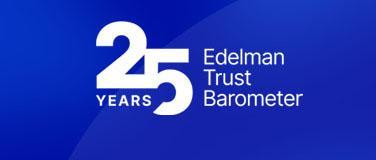I'm sure my wife and I were not alone on the iPlayer watching Ezra Collective at Glastonbury, wishing we were there.
The sun was setting and drummer Femi Koleoso stepped up to the mic and launched into a powerful sermon. At a time where we increasingly feel separation and loneliness, what binds us?
His answer: Joy. Its power to unite even happiness with sadness.
Through his words I saw a pathway to help how we adapt in what feels like unrelenting change and social dislocation at a time of constant innovation.
Because as much as we ask people to adopt new technologies, behaviours and narratives about what the future holds, in reality most are still bracing. Less for what's coming, and more for what might be lost along the way.
The Great Transfer of Trust
The 2025 Edelman Trust Barometer shows the weight of this strain. Trust inequality between the average trust in institutions of high and low-income groups has widened to double digits in most countries. Grievance is high in many developed markets and belief in a better future is at stunning lows. Trust in institutions has not grown despite political changes and economic shifts.
There is a widespread sense of grievance, believing that the actions of business and government are hurting us; serving only a select few in a system that favours the rich, where the rich are getting richer.
But it's brands that are now tasked with filling this space. According to the 2025 Trust Barometer Special Report: Brand Trust, From We to Me, people now place more trust in the brands they use than in business, government, media, and even NGOs.
At a time where the perceived withdrawal of these institutions is leaving many feeling more isolated, brands are present in the small daily moments. And in a climate of volatility, that presence carries weight. But being there is about more than presence.
Over the past five years, people’s expectations of brands have grown more personal, more emotional, and more expansive. They now look to brands to play five very human roles, each tied to a rising importance over the last 5 years:
- Give me optimism (76%) – Offer a sense that things can get better, even when progress feels hard to see.
- Make me feel good (74%) – Provide comfort, ease, and emotional lift in moments that feel uncertain or overwhelming.
- Help me do good (75%) – Enable people to act in ways that align with their values, without requiring grand gestures.
- Provide me with a sense of community (73%) – Create space for belonging, even if just in passing, shared experience.
- Teach me something useful (71%) – Help us navigate complexity, make better choices, and feel more equipped.
Somatic Readiness
These asks are functional signals of stability and care. Together, they tell people: you’re not alone in this. This is a call to action for all, even for brands that show up quietly in our busy lifestyles. When everything else feels uncertain, these are the brands people rely on to hold the line.
Meeting these expectations has a steadying effect, whether it's connection, lifting the mood, a sense of purpose or just a learning moment. To be clear, these are not brand differentiators but readiness cues. Signals that say: you can trust this and move now. You are ready.
This trust signal is best described as somatic readiness, what happens when the body says yes before the mind fully understands why. Our shoulders loosen, breathing settles, we become more willing to try, explore or consider.
Somatic readiness makes space for action by loosening the grip of uncertainty and lowering the emotional cost of trying something new. It relaxes the body and opens us to the future.
This is the starting point for how we deliver what I've described as innovation at the speed of trust.
In this state, innovation lands because it's both exciting and feels within our reach. It means we're noticing whether people are listening or simply bracing for change, designing for the nervous system as much as for the message. Because progress can’t land in a body that still feels under threat.
Brands that understand this won’t just communicate better. They’ll move better, becoming interpreters of change and translators of what’s new into what’s possible.
Tech availability
Tech brands most often stand at the hard edge of somatic readiness. At the same time, tech companies have long been among the most trusted businesses.
Yet that trust is no longer unconditional. While 76% globally still say they trust tech to do what is right, not all tech or tech brands are seen the same. At a time where the biggest conversation about technological change is centred on Artificial Intelligence, trust in AI companies is falling, as is enthusiasm for the technology.
Fewer than 1 in 2 are comfortable with the business use of AI and those with the highest sense of grievance (those who feel most let down by the system) are 2 points less trusting of AI than those with a low sense of grievance.
This suggests we are at a critical juncture. Reframe what trust looks and feels like beyond institutional loyalty into something closer, quieter, and more grounded in people’s real experience.
In these everyday moments trust might simply mean being available with the ability to lower tension, show up consistently and give people back a sense of rhythm when the future feels out of sync.
For tech brands as harbingers of the future, this doesn’t mean withdrawing from embedding purpose in innovation but instead adding a context people recognise. Introducing change in ways that don’t overwhelm the nervous system and being patient enough to earn belief, and present enough to sustain it.
More belief
Another inspiring moment at Glastonbury came from Kae Tempest. A set stripped of spectacle, anchored in language and presence. The message: more belief in each other, the possibility of something better.
That’s what trust can do and why tech brands have a role to play by helping create the conditions where more belief can grow.
Through this lens, trust is less a crescendo and more a pulse, repeated, grounded and steady. The kind of drumbeat you don’t notice until it’s gone. But when it’s present, people pick up the rhythm because they’re inspired and feel safe enough to move.
Innovation becomes a reason for hope.
Sat Dayal is Managing Director of Technology at Edelman UK.

